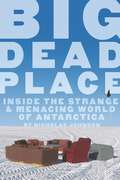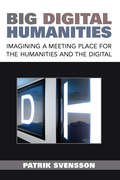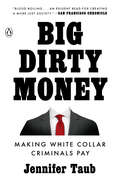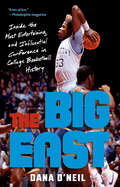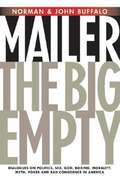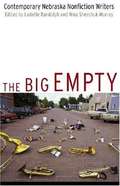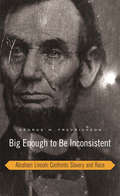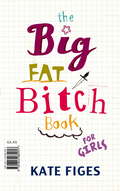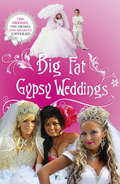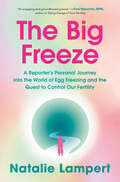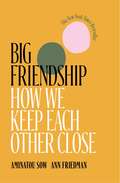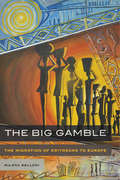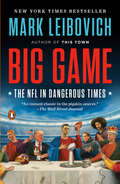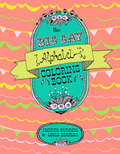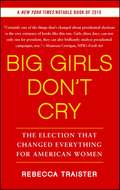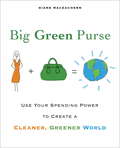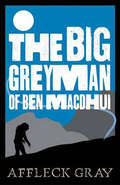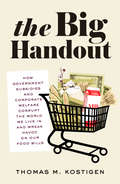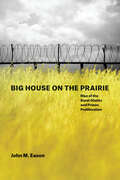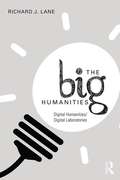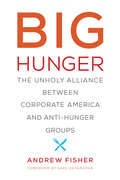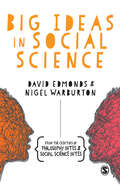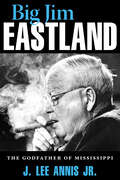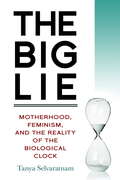- Table View
- List View
Big Dead Place
by Nicholas JohnsonJohnson's savagely funny [book] is a grunt's-eye view of fear and loathing, arrogance and insanity in a dysfunctional, dystopian closed community. It's like M*A*S*H on ice, a bleak, black comedy."--The Times of London
Big Digital Humanities: Imagining a Meeting Place for the Humanities and the Digital
by Patrik SvenssonBig Digital Humanities has its origins in a series of seminal articles Patrik Svensson published in the Digital Humanities Quarterly between 2009 and 2012. As these articles were coming out, enthusiasm around Digital Humanities was acquiring a great deal of momentum and significant disagreement about what did or didn't "count" as Digital Humanities work. Svensson's articles provided a widely sought after omnibus of Digital Humanities history, practice, and theory. They were informative and knowledgeable and tended to foreground reportage and explanation rather than utopianism or territorial contentiousness. In revising his original work for book publication, Svensson has responded to both subsequent feedback and new developments. Svensson's own unique perspective and special stake in the Digital Humanities conversation come from his role as Director of the HUMlab at Umea University. HUMlab is a unique collaborative space and Digital Humanities center, which officially opened its doors in 2000. According to its own official description, the HUMlab is an open, creative studio environment where "students, researchers, artists, entrepreneurs and international guests come together to engage in dialogue, experiment with technology, take on challenges and move scholarship forward." It is this last element "moving scholarship forward" that Svensson argues is the real opportunity in what he terms the "big digital humanities," or digital humanities as practiced in collaborative spaces like the HUMlab, and he is uniquely positioned to take an account of this evolving dimension of Digital Humanities practice.
Big Dirty Money: The Shocking Injustice and Unseen Cost of White Collar Crime
by Jennifer TaubHow ordinary Americans suffer when the rich and powerful break the law to get richer and more powerful--and how we can stop it.There is an elite crime spree happening in America, and the privileged perps are getting away with it. Selling loose cigarettes on a city sidewalk can lead to a choke-hold arrest, and death, if you are not among the top 1%. But if you're rich and commit mail, wire, or bank fraud, embezzle pension funds, lie in court, obstruct justice, bribe a public official, launder money, or cheat on your taxes, you're likely to get off scot-free (or even win an election). When caught and convicted, such as for bribing their kids' way into college, high-class criminals make brief stops in minimum security "Club Fed" camps. Operate the scam from the executive suite of a giant corporation, and you can prosper with impunity. Consider Wells Fargo & Co. Pressured by management, employees at the bank opened more than three million bank and credit card accounts without customer consent, and charged late fees and penalties to account holders. When CEO John Stumpf resigned in "shame," the board of directors granted him a $134 million golden parachute.This is not victimless crime. Big Dirty Money details the scandalously common and concrete ways that ordinary Americans suffer when the well-heeled use white collar crime to gain and sustain wealth, social status, and political influence. Profiteers caused the mortgage meltdown and the prescription opioid crisis, they've evaded taxes and deprived communities of public funds for education, public health, and infrastructure. Taub goes beyond the headlines (of which there is no shortage) to track how we got here (essentially a post-Enron failure of prosecutorial muscle, the growth of "too big to jail" syndrome, and a developing implicit immunity of the upper class) and pose solutions that can help catch and convict offenders.
The Big East: Inside the Most Entertaining and Influential Conference in College Basketball History
by Dana O'NeilThe definitive, compulsively readable story of the greatest era of the most iconic league in college basketball history—the Big East&“This book captures the inside of a special time in Big East basketball. If you love the game, this book is a must read!&”—Jim Calhoun, former University of Connecticut men&’s basketball coachThe names need no introduction: Thompson and Patrick, Boeheim and the Pearl, and of course Gavitt. And the moments are part of college basketball lore: the Sweater Game, Villanova Beats Georgetown, and Six Overtimes. But this is the story of the Big East Conference that you haven&’t heard before—of how the Northeast, once an afterthought, became the epicenter of college basketball.Before the league&’s founding, East Coast basketball had crowned just three national champions in forty years, and none since 1954. But in the Big East&’s first ten years, five of its teams played for a national championship. The league didn&’t merely inherit good teams; it created them. But how did this unlikely group of schools come to dominate college basketball so quickly and completely?Including interviews with more than sixty of the key figures in the conference&’s history, The Big East charts the league&’s daring beginnings and its incredible rise. It transports fans inside packed arenas to epic wars fought between transcendent players, and behind locker-room doors where combustible coaches battled even more fiercely for a leg up.Started on a handshake and a prayer, the Big East carved an improbable arc in sports history, an ensemble of Catholic schools banding together to not only improve their own stations but rewrite the geographic boundaries of basketball. As former UConn coach Jim Calhoun eloquently put it, &“It was Camelot. Camelot with bad language.&”
The Big Empty: Dialogues on Politics, Sex, God, Boxing, Morality, Myth, Poker, and Bad Conscience in America
by Norman Mailer John Buffalo MailerSet against the backdrop of George W. Bush's re-election campaign and the war in Iraq, John asks his father to look back to World War II and explore the parallels that can and cannot be drawn between that time and our current post-9/11 consciousness.
The Big Empty: Contemporary Nebraska Nonfiction Writers
by Ladette Randolph Nina Shevchuk-MurrayExploring the State of Nebraska from its rural reaches to its urban engines, from its marvelous ecosystems to its myriad historical and cultural offerings, these narratives evoke Nebraska in all its facets.
Big Enough to Be Inconsistent: Abraham Lincoln Confronts Slavery and Race (The W. E. B. Du Bois Lectures)
by George M. Fredrickson“Cruel, merciful; peace-loving, a fighter; despising Negroes and letting them fight and vote; protecting slavery and freeing slaves.” Abraham Lincoln was, W. E. B. Du Bois declared, “big enough to be inconsistent.” Big enough, indeed, for every generation to have its own Lincoln—unifier or emancipator, egalitarian or racist. In an effort to reconcile these views, and to offer a more complex and nuanced account of a figure so central to American history, this book focuses on the most controversial aspect of Lincoln’s thought and politics—his attitudes and actions regarding slavery and race. Drawing attention to the limitations of Lincoln’s judgment and policies without denying his magnitude, the book provides the most comprehensive and even-handed account available of Lincoln’s contradictory treatment of black Americans in matters of slavery in the South and basic civil rights in the North. George Fredrickson shows how Lincoln’s antislavery convictions, however genuine and strong, were held in check by an equally strong commitment to the rights of the states and the limitations of federal power. He explores how Lincoln’s beliefs about racial equality in civil rights, stirred and strengthened by the African American contribution to the northern war effort, were countered by his conservative constitutional philosophy, which left this matter to the states. The Lincoln who emerges from these pages is far more comprehensible and credible in his inconsistencies, and in the abiding beliefs and evolving principles from which they arose. Deeply principled but nonetheless flawed, all-too-human yet undeniably heroic, he is a Lincoln for all generations.
The Big Fat Bitch Book
by Kate FigesWhy do women excel at bitching? And are there ways to do it well?In this unique and entertaining book, Kate Figes explores girltalk, the way bitching erupts amongst teenage girls, the tenacity of female stereotypes as well as essential guidance on being the best kind of bitch - strong and self-assured rather than the bitch that needs to put other women down to feel stronger. Packed with witty anecdote, etiquette, interviews and contributions from strong bitches such as Kathy Lette, Wendy Holden and Virginia Ironside this is a must read for all women on the most delicious, yet dangerous of verbal art forms.
Big Fat Gypsy Weddings: The Dresses, the Drama, the Secrets Unveiled
by Jim NallyBig Fat Gypsy Weddings has been the most talked-about show on TV and delivered ratings almost as enormous as the frothy, bejewelled frocks its subjects wear. <P><P>This book offers a window into the secret and surprising world of Gypsies and Travellers in Britain today. From spectacular first communions, strict courtings and jaw-dropping weddings, this book covers all the extraordinary rite-of-passage events in a Gypsy's life and offers an insight into their fascinating world. <P>All the favourite characters from the show are there - from Thelma the miracle dressmaker to Paddy, the champion bare-knuckle boxer. Warm, engrossing and funny, Big Fat Gypsy Weddings lays bare an exotic unseen Britain that exists right on our doorstep.
The Big Freeze: A Reporter's Personal Journey into the World of Egg Freezing and the Quest to Control Our Fertility
by Natalie LampertA fascinating investigation into the lucrative, minimally regulated, fast-growing industry of egg freezing, from a young reporter on a personal journey into the world of cutting-edge reproductive medicine&“An engaging and groundbreaking book.&”—Toni Weschler, MPH, author of Taking Charge of Your FertilityOvaries. Most women have two; journalist Natalie Lampert has only one. Then, in her early twenties, she almost lost it, along with her ability to ever have biological children. Doctors urged her to freeze her eggs, and Lampert started asking questions. The Big Freeze is the story of Lampert&’s personal quest to investigate egg freezing, as well as the multibillion-dollar femtech industry, in order to decide the best way to preserve her own fertility. She attended flashy egg-freezing parties, visited high-priced fertility clinics, talked to dozens of women who froze their eggs, toured the facility in Italy where the technology was developed, and even attended a memorial service for thousands of accidentally destroyed embryos. What was once science fiction is now simply science: Fertility can be frozen in time. Between 2009 and 2022, more than 100,000 women in the United States opted to freeze their eggs. Along with in vitro fertilization, egg freezing is touted as a way for women to &“have it all&” by conquering their biological clocks, in line with the global trend of delaying childbirth. A generation after the Pill, this revolutionary technology offers a new kind of freedom for women. But does egg freezing give women real agency or just the illusion of it?A personal and deeply researched guide to the pros, cons, and many facets of this wildly popular technology, The Big Freeze is a page-turning exploration of the quest to control fertility, with invaluable information that answers the questions women have been afraid to ask—or didn&’t know they should ask in the first place.
Big Friendship: How We Keep Each Other Close
by Aminatou Sow Ann FriedmanA close friendship is one of the most influential and important relationships a human life can contain. Anyone will tell you that! But for all the rosy sentiments surrounding friendship, most people don&’t talk much about what it really takes to stay close for the long haul.Now two friends, Aminatou Sow and Ann Friedman, tell the story of their equally messy and life-affirming Big Friendship in this honest and hilarious book that chronicles their first decade in one another&’s lives. As the hosts of the hit podcast Call Your Girlfriend, they&’ve become known for frank and intimate conversations. In this book, they bring that energy to their own friendship—its joys and its pitfalls. Aminatou and Ann define Big Friendship as a strong, significant bond that transcends life phases, geographical locations, and emotional shifts. And they should know: the two have had moments of charmed bliss and deep frustration, of profound connection and gut-wrenching alienation. They have weathered life-threatening health scares, getting fired from their dream jobs, and one unfortunate Thanksgiving dinner eaten in a car in a parking lot in Rancho Cucamonga. Through interviews with friends and experts, they have come to understand that their struggles are not unique. And that the most important part of a Big Friendship is making the decision to invest in one another again and again. An inspiring and entertaining testament to the power of society&’s most underappreciated relationship, Big Friendship will invite you to think about how your own bonds are formed, challenged, and preserved. It is a call to value your friendships in all of their complexity. Actively choose them. And, sometimes, fight for them.
The Big Gamble: The Migration of Eritreans to Europe
by Milena BelloniA free open access ebook is available upon publication. Learn more at www.luminosoa.org. Tens of thousands of Eritreans make perilous voyages across Africa and the Mediterranean Sea every year. Why do they risk their lives to reach European countries where so many more hardships await them? By visiting family homes in Eritrea and living with refugees in camps and urban peripheries across Ethiopia, Sudan, and Italy, Milena Belloni untangles the reasons behind one of the most under-researched refugee populations today. Balancing encounters with refugees and their families, smugglers, and visa officers, The Big Gamble contributes to ongoing debates about blurred boundaries between forced and voluntary migration, the complications of transnational marriages, the social matrix of smuggling, and the role of family expectations, emotions, and values in migrants’ choices of destinations.
Big Game: The NFL in Dangerous Times
by Mark LeibovichFrom the #1 New York Times bestselling author of This Town, an equally merciless probing of America's biggest cultural force, pro football, at a moment of peak success and high anxiety <P><P>Like millions of Americans, Mark Leibovich has spent more of his life tuned into pro football than he'd care to admit. <P><P>Being a lifelong New England Patriots fan meant growing up on a steady diet of lovable loserdom. That is, until the Tom Brady/Bill Belichick era made the Pats the most ruthlessly efficient and polarizing sports dynasty of the modern NFL, and its fans the most irritating in all of Pigskin America. Leibovich kept his obsession quiet, making a nice career for himself covering that other playground for rich and overgrown children, American politics. <P><P>Still, every now and then Leibovich would reach out to Tom Brady to gauge his willingness to subject himself to a profile. He figured that the chances of Brady agreeing were a Hail Mary at best, but Brady returned Mark's call in summer 2014 and kept on returning his calls through epic Patriots Super Bowl victory and defeat, and a scandal involving Brady--Deflategate--whose grip on sports media was as profound as its true significance was ridiculous. <P><P>So began a four-year odyssey that took Mark Leibovich deeper inside the NFL than anyone has gone before. From the owners' meeting to the draft to the sidelines of crucial games, he takes in the show at the elbow of everyone from Brady to big-name owners to the cordially despised NFL Commissioner, Roger Goodell. <P><P>Ultimately, BIG GAME is a chronicle of "peak football"--the high point of the sport's economic success and cultural dominance, but also the time when the dark side began to show. It is an era of explosive revenue growth, but also one of creeping existential fear. Players have long joked that NFL stands for "not for long," but as the true impact of concussions becomes inescapable background noise, it's increasingly difficult to enjoy the simple glory of football without the buzz-kill of its obvious consequences. <P><P>And that was before Donald Trump. In 2016, Mark's day job caught up with him, and the NFL slammed headlong into America's culture wars. <P><P>BIG GAME is a journey through an epic storm. Through it all, Leibovich always keeps one eye on Tom Brady and his beloved Patriots, through to the 2018 Super Bowl. Pro football, this hilarious and enthralling book proves, may not be the sport America needs, but it is most definitely the sport we deserve. <P><b>A New York Times Bestseller</b>
The Big Gay Alphabet Coloring Book (Reach and Teach)
by Jacinta BunnellGrab your crayons and your backpack for a fantastical journey through The Big Gay Alphabet Coloring Book, an activity book for adults that highlights memorable victories and collective moments in lesbian, gay, bisexual, transgender, queer, questioning, and pansexual culture. Each unique page, made up of inked and framed line drawings with beautiful typography, is reminiscent of a handsomely designed, vintage children's alphabet book and aims to bring greater understanding of gender fluidity, gender diversity, and sexual orientation.
Big Girls Don't Cry: The Election that Changed Everything for American Women
by Rebecca TraisterJournalist and Salon writer Rebecca Traister investigates the 2008 presidential election and its impact on American politics, women and cultural feminism. Examining the role of women in the campaign, from Clinton and Palin to Tina Fey and young voters, Traister confronts the tough questions of what it means to be a woman in today's America.The 2008 campaign for the presidency reopened some of the most fraught American conversations--about gender, race and generational difference, about sexism on the left and feminism on the right--difficult discussions that had been left unfinished but that are crucial to further perfecting our union. Though the election didn't give us our first woman president or vice president, the exhilarating campaign was nonetheless transformative for American women and for the nation. In Big Girls Don't Cry, her electrifying, incisive and highly entertaining first book, Traister tells a terrific story and makes sense of a moment in American history that changed the country's narrative in ways that no one anticipated. Throughout the book, Traister weaves in her own experience as a thirtysomething feminist sorting through all the events and media coverage--vacillating between Hillary Clinton and Barack Obama and questioning her own view of feminism, the women's movement, race and the different generational perspectives of women working toward political parity. Electrifying, incisive and highly entertaining, Big Girls Don't Cry offers an enduring portrait of dramatic cultural and political shifts brought about by this most historic of American contests.
Big Green Purse: Use Your Spending Power to Create a Cleaner, Greener World
by Diane MaceachernProtecting our environment is one of the biggest issues facing our planet today. But how do we solve a problem that can seem overwhelming-even hopeless? As Diane MacEachern argues in Big Green Purse, the best way to fight the industries that pollute the planet, thereby changing the marketplace forever, is to mobilize the most powerful consumer force in the world-women. MacEachern's message is simple but revolutionary. If women harness the "power of their purse" and intentionally shift their spending money to commodities that have the greatest environmental benefit, they can create a cleaner, greener world. Spirited and informative, this book: - targets twenty commodities-cars, cosmetics, coffee, food, paper products, appliances, cleansers, and more-where women's dollars can make a dramatic difference; - provides easy-to-follow guidelines and lists so women can choose the greenest option regardless of what they're buying, along with recommended companies they should support; - encourages women to spend wisely by explaining what's worth the premium price some green products cost, what's not, and when they shouldn't spend money at all; and - differentiates between products that are actually "green" and those that are simply marketed as "ecofriendly." Whether readers want to start with small changes or are ready to devote the majority of their budget to green products, MacEachern offers concrete and immediate ways that women can take action and make a difference. Empowering and enlightening, Big Green Purse will become the "green shopping bible" for women everywhere who are asking, "What can I do? "
The Big Grey Man of Ben MacDhui
by Affleck GrayA chilling look at the mysterious Gaelic legend stalking the highest peak of the Cairngorms, the mountains in the eastern Highlands of Scotland. An acclaimed account of the terrifying figure said to haunt the desolate passes and summit of Britain&’s second highest mountain, this book takes on one of Scotland&’s most chilling unsolved mysteries. Throughout the years, countless climbers have either seen or sensed the presence of some extraordinary being in the misty wilderness of Ben MacDhui. This book explores the evidence and also looks at similar stories from around the world to try and make sense of this bizarre phenomenon.
The Big Handout: How Government Subsidies and Corporate Welfare Corrupt the World We Live In and Wreak Havoc on Our Food Bills
by Thomas M. KostigenJust reading the word "subsidies" may cause many people's eyes to glaze over. We don't think it affects us directly, so we tune out. But it turns out that this complicated-sounding issue has an enormous impact on all of us. The Big Handout is about bad fiscal, environmental, agricultural, water, energy, health, and foreign policies. And it's a story about just one thing—subsidies.A subsidy is a grant by the government to a private business that is deemed advantageous to the public. Cotton, wheat, corn, soy, and oil are the most subsidized commodities in the United States. In this eye-opening book, New York Times bestselling author Thomas Kostigen explores government policies that cost taxpayers $200 billion per year, over $1,500 per household. In some cases we pay more for subsidized goods than we'd pay in a free market—and, in the most shocking abuses of the subsidy system, we pay for goods that aren't even produced.The Big Handout exposes how artificial pricing hurts us and people worldwide, from our waistlines and pocketbooks to our health. By revealing just how toxic America's subsidy system has become, for everyone, The Big Handout is a wake-up call that empowers readers to effect change.
Big House on the Prairie: Rise of the Rural Ghetto and Prison Proliferation
by John M. EasonFor the past fifty years, America has been extraordinarily busy building prisons. Since 1970 we have tripled the total number of facilities, adding more than 1,200 new prisons to the landscape. This building boom has taken place across the country but is largely concentrated in rural southern towns. In 2007, John M. Eason moved his family to Forrest City, Arkansas, in search of answers to key questions about this trend: Why is America building so many prisons? Why now? And why in rural areas? Eason quickly learned that rural demand for prisons is complicated. Towns like Forrest City choose to build prisons not simply in hopes of landing jobs or economic wellbeing, but also to protect and improve their reputations. For some rural leaders, fostering a prison in their town is a means of achieving order in a rapidly changing world. Taking us into the decision-making meetings and tracking the impact of prisons on economic development, poverty, and race, Eason demonstrates how groups of elite whites and black leaders share power. Situating prisons within dynamic shifts that rural economies are undergoing and showing how racially diverse communities lobby for prison construction, Big House on the Prairie is a remarkable glimpse into the ways a prison economy takes shape and operates.
The Big Humanities: Digital Humanities/Digital Laboratories
by Richard J. LaneThis book provides an accessible introduction to, and overview of, the digital humanities, one of the fastest growing areas of literary studies. Lane takes a unique approach by focusing on the technologies and the new environment in which the digital humanities largely takes place: the digital laboratory. The book provides a brief history of DH, explores and explains the methodologies of past and current DH projects, and offers resources such as detailed case studies and bibliographies. Further, the focus on the digital laboratory space reveals affiliations with the types of research that have traditionally taken place in the sciences, as well as convergences with other fast-growing research spaces, namely innovation labs, fabrication labs, maker spaces, digital media labs, and change labs. The volume highlights the profound transformation of literary studies that is underway, one in which the adoption of powerful technology – and concomitantly being situated within a laboratory environment – is leading to an important re-engagement in the arts and humanities, and a renewed understanding of literary studies in the digital age, as well as a return to large-scale financial investment in humanistic research. It will be useful to students and teachers, as well as administrators and managers in charge of research infrastructure and funding decisions who need an accessible overview of this technological transformation in the humanities. Combining useful detail and an overview of the field, the book will offers accessible entry into this rapidly growing field.
Big Hunger: The Unholy Alliance between Corporate America and Anti-Hunger Groups (Food, Health, and the Environment)
by Andrew FisherHow to focus anti-hunger efforts not on charity but on the root causes of food insecurity, improving public health, and reducing income inequality. Food banks and food pantries have proliferated in response to an economic emergency. The loss of manufacturing jobs combined with the recession of the early 1980s and Reagan administration cutbacks in federal programs led to an explosion in the growth of food charity. This was meant to be a stopgap measure, but the jobs never came back, and the “emergency food system” became an industry. In Big Hunger, Andrew Fisher takes a critical look at the business of hunger and offers a new vision for the anti-hunger movement. From one perspective, anti-hunger leaders have been extraordinarily effective. Food charity is embedded in American civil society, and federal food programs have remained intact while other anti-poverty programs have been eliminated or slashed. But anti-hunger advocates are missing an essential element of the problem: economic inequality driven by low wages. Reliant on corporate donations of food and money, anti-hunger organizations have failed to hold business accountable for offshoring jobs, cutting benefits, exploiting workers and rural communities, and resisting wage increases. They have become part of a “hunger industrial complex” that seems as self-perpetuating as the more famous military-industrial complex. Fisher lays out a vision that encompasses a broader definition of hunger characterized by a focus on public health, economic justice, and economic democracy. He points to the work of numerous grassroots organizations that are leading the way in these fields as models for the rest of the anti-hunger sector. It is only through approaches like these that we can hope to end hunger, not just manage it.
Big Ideas in Social Science
by David Edmonds Nigel WarburtonAre human beings less violent than before? Why do we adopt certain moral and political judgements? Why is the gap between rich and poor getting bigger? How do we decide which criminal policies are effective? What is the Population Challenge for the 21st Century? What is social science? In Big Ideas in Social Science, David Edmonds and Nigel Warburton put these and more of our society’s burning questions to 18 of the world’s leading social scientists including Steven Pinker, Ann Oakley, Lawrence Sherman, Kate Pickett, Robert J. Shiller and Doreen Massey. The result is a collection of thought-provoking discussions that span the fields of sociology, politics, economics, criminology, geography and many more.From the people who brought us the Philosophy Bites series, Big Ideas in Social Science is a fascinating and accessible introduction to the key ideas and findings of the social sciences. The interviews for this book are based on a series of podcasts, Social Science Bites, sponsored by SAGE. Social Science Bites was inspired by the popular Philosophy Bites podcast (www.philosophybites.com), which was founded by David and Nigel in 2007 and has so far had 26 million downloads. Philosophy Bites has spawned three books, Philosophy Bites, Philosophy Bites Back and Philosophy Bites Again.
Big Ideas in Social Science
by David Edmonds Nigel WarburtonAre human beings less violent than before? Why do we adopt certain moral and political judgements? Why is the gap between rich and poor getting bigger? How do we decide which criminal policies are effective? What is the Population Challenge for the 21st Century? What is social science? In Big Ideas in Social Science, David Edmonds and Nigel Warburton put these and more of our society's burning questions to 18 of the world's leading social scientists including Steven Pinker, Ann Oakley, Lawrence Sherman, Kate Pickett, Robert J. Shiller and Doreen Massey. The result is a collection of thought-provoking discussions that span the fields of sociology, politics, economics, criminology, geography and many more.From the people who brought us the Philosophy Bites series, Big Ideas in Social Science is a fascinating and accessible introduction to the key ideas and findings of the social sciences. The interviews for this book are based on a series of podcasts, Social Science Bites, sponsored by SAGE. Social Science Bites was inspired by the popular Philosophy Bites podcast (www.philosophybites.com), which was founded by David and Nigel in 2007 and has so far had 26 million downloads. Philosophy Bites has spawned three books, Philosophy Bites, Philosophy Bites Back and Philosophy Bites Again.
Big Jim Eastland: The Godfather of Mississippi
by J. Lee Annis Jr.For decades after the Second World War, Senator James O. Eastland (1904–1986) was one of the more intransigent leaders of the Deep South's resistance to what he called “the Second Reconstruction.” And yet he developed, late in his life, a very real friendship with state NAACP chair Aaron Henry. Big Jim Eastland provides the life story of this savvy, unpredictable powerhouse. From 1947 to 1978, Eastland wore that image of resistance proudly, even while recognizing from the beginning his was the losing side. Biographer J. Lee Annis Jr. chronicles such complexities extensively and also delves into many facets lesser known to the general public. Born in the Mississippi Delta as part of the elite planter class, Eastland was appointed to the US Senate in 1941 by Democratic Governor Paul B. Johnson Sr. Eastland ran for and won the Senate seat outright in 1942 and served in the Senate from 1943 until his retirement in 1978. A blunt man of few words but many contradictions, Eastland was an important player in Washington, from his initial stint in 1941 where he rapidly salvaged several key local projects from bungling intervention, to the 1970s when he shepherded the Supreme Court nominees of Richard Nixon and Gerald Ford to Senate confirmation. Annis paints a full picture of the man, describing the objections Eastland raised to civil rights proposals and the eventual accommodations he needed to accept after the passage of the Voting Rights Act of 1965.
The Big Lie
by Tanya SelvaratnamA candid assessment of the pros and cons of delayed motherhood. Biology does not bend to feminist ideals and science does not work miracles. That is the message of this eye-opening discussion of the consequences of delayed motherhood. Part personal account, part manifesto, Selvaratnam recounts her emotional journey through multiple miscarriages after the age of 37. Her doctor told her she still "had time," but Selvaratnam found little reliable and often conflicting information about a mature woman's biological ability (or inability) to conceive. Beyond her personal story, the author speaks to women in similar situations around the country, as well as fertility doctors, adoption counselors, reproductive health professionals, celebrities, feminists, journalists, and sociologists. Through in-depth reporting and her own experience, Selvaratnam urges more widespread education and open discussion about delayed motherhood in the hope that long-lasting solutions can take effect. The result is a book full of valuable information that will enable women to make smarter choices about their reproductive futures and to strike a more realistic balance between science, society and personal goals.From the Trade Paperback edition.
